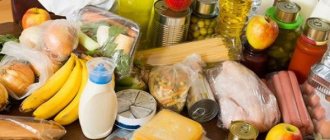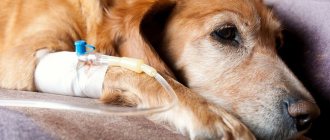Our children are very inquisitive and curious. They explore the world and try to taste everything. Unfortunately, children's curiosity and parental inattention often become a harbinger of trouble - poisoning in a child.
If medicines, cosmetics or household chemicals are stored at home in a place accessible to children, the child may try them, tempted by the bright packaging or delicious smell. Alas, often the result of such a “tasting” can be poisoning of a child.
Danger awaits children in the lap of nature: fragrant flowers, berries, bright mushroom caps also cause poisoning of children who eat this “beauty.”
Food poisoning in a child occurs when eating poor-quality food or products contaminated with microorganisms or fungi.
Mass poisonings, such as salmonellosis, also occur in children's groups.
In adolescence, there is a desire to “try everything” - toxic substances, medications, and sometimes drugs. Such experiments often end in acute poisoning of the child or substance abuse (drug addiction).
Poisoning in a child is divided into periods:
- asymptomatic period - the time from the moment a toxic substance enters the body until the initial manifestations of poisoning (fever, vomiting, diarrhea);
- intoxication is the period from the moment when the poison has already been absorbed into the blood until the toxic substance is completely removed from the body. It is at this stage that it is important to provide timely and correct assistance to the child. Otherwise, dysfunction of various internal organs and the brain is possible.
After poisoning, a child may experience insidious consequences - complications: kidney or liver failure, disorders of the nervous system, heart, lungs.
After food poisoning, the functioning of internal organs is restored. The duration of the period depends on the severity of intoxication, timeliness of treatment and concomitant diseases of the child.
Signs of poisoning
Doctors regard a sudden deterioration in the child’s health – vomiting and diarrhea – as possible poisoning of children.
However, the symptoms in a child depend not only on the body’s “desire” to remove the poison, but also on the toxic properties of the substance itself that is ingested:
- vomiting without diarrhea may be a sign of nicotine poisoning;
- dilation of the pupils occurs with alcohol poisoning;
- nystagmus or strabismus - in case of fly agaric poisoning;
- constricted pupils are a sign of opiate poisoning;
- impaired color perception - carbon monoxide poisoning;
- paralysis, double vision - symptoms of botulism;
- blindness - methyl alcohol poisoning;
- diarrhea, abdominal pain and vomiting accompany food poisoning. When food is contaminated with bacteria, the temperature rises. In case of poisoning, a child experiences headache, drowsiness, and poor appetite.
Sources
- Novikova V.P., Gurova M.M., Khavkin A.I. Functional nausea and vomiting in children. Questions of children's dietetics. 2020; 18(4): 36–44
- Dubrovskaya M.I., Mukhina Yu.G., Shumilov P.V., & Volodina I.I. (2007). Regurgitation and vomiting syndrome in children of the first year of life: differential diagnosis and management tactics. Pediatrics. Journal named after G.N. Speransky, 86 (6), 18.
- Forbes D., Fairbrother S. Cyclic nausea and vomiting in childhood // Aust. Fam. Physician. - 2008. - 37(1-2).
- Boles R., Powers A., Adams K. Cyclic Vomiting Syndrome Plus // J. Child Neuro. - 2006. - 21(3).
- Muminova D.A. “Nosoological structure of recurrent vomiting in children” FORCIPE, no. Appendix, 2022, pp. 269-270.
How to treat poisoning in a child?
Therapy consists of main areas:
- Prevent the absorption of poison into the blood;
- Application of an antidote (antidote);
- Removing toxic compounds from the body;
- Treatment of symptoms of poisoning.
Difficulties in treating children under one year of age are associated with insufficient function of the kidneys and liver, the organs responsible for neutralizing toxins and removing them from the body.
It is important to know
Regardless of the type of plant poison, it is necessary to begin treating poisoning in children with gastric lavage.
The volume of water required for rinsing: 3 years - 6 years: take 16 ml of water per kilogram of child’s weight, 7 years and older - 14 ml per kilogram of weight. After emptying the stomach of food debris, give the child Enterosgel sorbent.
Poisoning in children should be treated as quickly as possible. Before the doctor arrives, it is necessary to compensate for the fluid lost through vomiting and diarrhea - to give the baby a drink. This will also quickly remove toxins from the body. Drinks are given a few teaspoons every 5-10 minutes.
Pharmaceutical solutions (rehydron and others), boiled water, carrot-rice or raisin infusions are used.
Fever in case of poisoning in a child is eliminated by taking antipyretic drugs.
If the baby is breastfed, in addition to milk, you should give him boiled water. And after some time after food poisoning, you can return to your normal feeding regimen.
Food poisoning in a child with mushrooms, poisonous plants, and chemicals is treated in a hospital setting.
Diarrhea
Mild diarrhea is common in babies. Moreover, due to the fact that children eat mainly liquid foods in the first few months of life, loose stools in infants should be considered normal. The danger may not be diarrhea itself, but the loss of fluid and salts.
What does it mean:
- Stools become more frequent;
- Very loose stool in a newborn;
- Increased fecal mass during bowel movements;
- “Flakes” appeared in the stool;
- The color and smell of the stool has changed.
Causes:
- Poorly washed bottle or dirty toy;
- Child overheating;
- Infection;
- Introduction of new dishes into the child’s diet;
- Use of certain medications;
- Fright.
What you can do:
- It is necessary to replenish fluid loss as soon as possible - apply it to the breast more often, the doctor may advise you to give him electrolyte solutions;
- If you cannot cope on your own within 2 days, consult a doctor.
When to worry:
- If diarrhea lasts more than 2 days;
- If the child has pallor, chapped lips, dry mouth;
- If the temperature rises, vomiting or rash begins;
- If you suspect that your baby's diarrhea is caused by taking medications.
In this case, you should consult a doctor. After all, loose stools threaten dehydration, which can damage a child’s body.
Diet for poisoning in a child
You need to start diet therapy with fasting. A child under 1 year of age who is breastfed misses several feedings. For older children, food is offered after the vomiting disappears.
What to feed a child if he is poisoned?
Food should be gentle on the stomach and intestines - this is a mandatory requirement for dietary dishes.
Pediatricians know what to feed a child in case of poisoning in order to provide the body with nutrients and enable it to recover from intoxication. Children who previously received complementary foods are given rice or buckwheat porridge prepared with milk and water in equal proportions. The porridge is pureed and diluted with hot milk. After a few days, you can give pureed vegetables. After 3-4 days - baby cottage cheese. Gradually, fish and meat are introduced into the diet in the form of a soufflé.
Children over one year old can be given biokefir or bioyogurt: they will ensure the restoration of the microflora of the large intestine after intoxication. The diet is expanding faster. Soups, purees, meat, fish, cereals are rubbed through a sieve.
What can a child eat if he is poisoned while vomiting?
To maintain water-salt balance, the baby should be given tea, rosehip decoction, salted or mineral water, and dried fruit compote. Feed only after vomiting has stopped.
Pediatrician Komarovsky believes that you should not force feed a child. Dishes on the children's menu should contain vitamins and be easy to digest, and drinks should be rich.
What can you eat if you are poisoned during diarrhea?
The menu should not include products that have a laxative effect and increase gas formation. During this period you cannot: baked goods, whole milk, brown bread.
Depending on the diagnosis, main symptoms, and diet treatment may vary significantly. In some cases, therapeutic fasting is recommended. After it, homemade crackers, oatmeal and rice porridge are gradually introduced. The first day the baby is fed often in small portions.
- What is allowed to eat? You can have mashed potatoes, rice porridge, white crackers, tea.
- What is strictly prohibited: fresh baked goods, pasta, chocolate, ice cream, chips.
The diet should be followed for about two weeks, then the child gradually returns to the regular menu.
Folk remedies
Traditional methods of treating vomiting involve using a special diet for a week. High protein foods should be selected. The consumption of carbohydrates and fats should be limited, and dairy products should be completely eliminated. Fruits, vegetables and fatty meats and fish are also excluded from the nutritious diet.
| Drink name | Image | Compound | Cooking Guide | Terms of use |
| Infusion of mint (melissa) | Mint, lemon balm - 1 tsp. Water – 200 ml | Pour boiling water over the chopped herbs. Leave for 20 minutes, strain | Take 40 ml at a time, no more than 3 cups/day. Course of treatment – 7-10 days | |
| Valerian root infusion | Crushed valerian root – ½ tsp. Water – 250 ml | Place valerian root in a thermos. Pour boiling water over and leave for 15-20 minutes. Strain | Take 2 tbsp. l. at a time, 1–2 cups/day. Course of treatment – 5-7 days | |
| Chamomile decoction | Chamomile baskets - 2 tsp. Water - 250 ml. | Boil water and put chamomile in it. Boil for 2–3 minutes, cool | Drink 50 ml at a time. Up to 3 cups/day. The decoction is taken for up to 10 days | |
| Ginger infusion | Ginger - 1 tsp. Water - 200 ml. | Grind the ginger root on a grater. Pour into a thermos, pour boiling water. Leave for 20 minutes, strain | Drink 2 tbsp. l. at a time, per day, no more than 1 cup. Course of treatment – 10 days | |
| Sweet green tea | Green tea - 1 tsp. Sugar - 1 tsp. Water - 250 ml. | Brew regular tea, add sugar | Drink in small sips an unlimited number of times. You can drink all the time | |
| Lemon zest infusion | Lemon zest - ½ tsp. Sugar - 1 tsp. Water - 200 ml. | Get the lemon zest, take ½ tsp, pour boiling water. Leave for 20 minutes, strain | Take 1-2 tbsp. l., alternating with plain water. No more than 1 cup per day. Treatment course 5 days |
The most common folk remedy for eliminating vomiting in children is peppermint. It contains essential oils that can relax the smooth muscles of the stomach and reduce the urge to vomit. To ensure the final result, you need to pour a glass of boiling water over a tablespoon of herbs and leave for two hours. You should take a tablespoon three times a day. In addition, mint tincture can eliminate the symptoms of vomiting, which is caused by overexertion and severe stress. Other ways to stop vomiting:
- Infusion of lemon balm. It is prepared in the same way as mint infusion.
- Valerian root decoction: pour boiling water over a teaspoon of crushed raw material and simmer over low heat for 10-15 minutes. Strain, cool and give your baby one teaspoon twice a day.
- Ginger drink: Stir one sixth of ginger powder in a glass of warm water. Children under three years of age can be given one to two teaspoons of ginger water three times a day. This folk remedy eliminates nausea and stops vomiting.
It must be understood that the use of antiemetic drugs does not relieve the child of the underlying disease, but only protects the child’s body from further development of irreversible consequences until medical assistance is provided.
What to feed a child after poisoning?
Dishes are warm, pureed or served in crushed form - rubbed through a sieve or processed in a blender.
What can you eat after poisoning? Ready-made baby products are perfect for this: meat and fish soufflés, vegetable purees, porridge or home-cooked boiled or steamed dishes. On the contrary, you should exclude: cucumbers, tomatoes, cabbage, wheat, pearl barley porridge.
What can you eat after a period of intoxication? During the recovery period, the menu consists of: boiled chicken meat, buckwheat porridge, natural yogurt, low-fat fish, kefir.
Diet period - 2-3 weeks from the moment of poisoning in children.
Treatment at home with the help of dietary nutrition will help to avoid chronic diseases of the digestive system and other complications.
Now let's talk about what to do while you are waiting for the doctor. So…
What is lactase deficiency
Breast milk contains everything a baby needs: easily digestible protein, calcium, fat-soluble vitamins, and fats and carbohydrates.
However, not all babies digest milk well. The most common cause is lactase deficiency, when the gastrointestinal tract cannot digest lactose - milk sugar, a complex of glucose and galactose, which makes up about 85% of all carbohydrates in breast milk.
Why does a child need lactose?
Lactose is the main sugar in a newborn’s diet, providing about 40% of its total energy expenditure.
Lactose and lactase
Lactose cannot be absorbed in the intestines in its pure form. First, it must be broken down into glucose and galactose molecules using the enzyme lactase. Its deficiency leads to impaired breakdown of lactose. This causes milk intolerance and is called “lactase deficiency.”
Causes:
- Congenital lactase deficiency is the complete inability of the newborn’s intestines to produce lactase. This is a very rare disease that develops due to a mutation in the genes responsible for the production of lactase.
- Transient lactase deficiency, a temporary inability to produce lactase, is common in many premature babies. This usually goes away within a few months after birth.
- Acquired lactase deficiency is caused by intestinal diseases. It usually develops in children suffering from food allergies, intestinal infections, and gluten intolerance. Once the disease is cured, the intestines' ability to produce lactase is completely restored.
How to recognize lactase deficiency? Symptoms of lactase deficiency:
- Very frequent watery stools;
- Allergic skin rash;
- True constipation (thick stool that is difficult to pass);
- Bloating;
- Excessive gas formation and colic.
You should contact your pediatrician and do a series of tests, based on which he will prescribe treatment.
First aid for child poisoning
Parents should be able to provide first aid to their child in case of poisoning before the ambulance arrives. This will help prevent the absorption of the toxic substance and reduce intoxication.
In case of poisoning with mushrooms, berries or medications, it is necessary to induce vomiting in the child by pressing on the root of the tongue. Rinse the stomach with a warm solution of table salt (2 - 4 teaspoons of salt per 1 glass of water) until the rinsing water is clean. The volume of liquid for gastric lavage should not be more than 3 liters.
What to give a child if he is poisoned?
After gastric lavage, enterosorbents are introduced inside to absorb the remaining poison.
They should be used as first aid for any food poisoning! But at the same time, it is necessary to know the permissible dosages and the preferred dosage form of the sorbent. For example, traditional activated carbon can damage the stomach lining of young children.
Modern silicon-containing sorbents (for example, Enterosgel) have high sorption activity, are available in gel form and are successfully used in pediatrics. Enterosgel absorbs not only pathogenic bacterial cells, but also their toxins, secondary mediators of inflammation, does not linger in the digestive system, is not absorbed, is suitable for long-term therapy and does not stain the stool, which is especially important during diagnosis.
Survey
Vomiting food is often a sign of the presence of functional or organic diseases of the digestive system, so diagnostics are carried out by a gastroenterologist, and research is aimed at a comprehensive study of the state of the gastrointestinal tract. The use of instrumental examination methods makes it possible to establish the root cause of vomiting, and laboratory tests are prescribed to confirm the diagnosis. In diagnostic terms, the most valuable are:
- Endoscopic examination
. Using endoscopy, the condition of the esophageal, gastric and duodenal mucosa is visualized. The method makes it possible to identify large tumors, strictures and cicatricial deformities of the digestive canal. In doubtful cases, a biopsy of pathological lesions is additionally recommended for further histological examination. - Radiography
. The method of x-ray imaging using an oral contrast agent is highly informative - it helps to assess the nature and coherence of the gastric and esophageal sphincters, and determine the speed of movement of food through the gastrointestinal tract. Radiography is also necessary to detect organic lesions. - Ultrasonography
. Ultrasound of the abdominal cavity belongs to the group of rapid non-invasive methods that are prescribed for screening examination of gastroenterological patients and selection of further tactics. According to indications, after survey sonography, targeted ultrasound of individual organs is performed to detect pathological changes. - Esophageal manometry.
If vomiting is of possible esophageal origin, the pressure in different parts of the organ must be measured. Usually, a study of the contractions of the upper and lower smooth muscle sphincters is performed, as well as an assessment of the pressure in the body of the esophagus. If necessary, the study is supplemented with antroduodenal manometry. - Bacteriological studies
. Dyspeptic symptoms are possible with various intestinal infections. In order to exclude this group of diseases, it is necessary to culture feces and vomit on nutrient media, which makes it possible to identify the main pathogens. If the infectious etiology of the process is confirmed, the blood is additionally examined for antibodies.
If there is a probable connection between vomiting of eaten foods and disorders of the acid-producing function of the stomach, it is advisable to measure the acidity of gastric juice and the amount of free hydrochloric acid. A biochemical blood test is indicated to determine the level of amylase, lipase, gastrin, and pepsinogen concentrations. In the absence of organic lesions of the digestive organs, a neurological examination is prescribed to exclude functional disorders.
Esophagogastroduodenoscopy
How to take Enterosgel for children?
Children are recommended to take Enterosgel 3 times a day:
- 5 – 14 years – dessert spoon;
- 2 years - 5 years - tea.
- In case of severe acute poisoning, doctors allow a dosage to be doubled.
Enterosgel should be in every home medicine cabinet, especially in summer!
A few hours later, already in the hospital, the doctors repeat gastric lavage for the child, after which they give a saline laxative (magnesium sulfate in a dose of 15 - 20 g in 100 ml of water).
If the cause of intoxication is reliably known - in the early period of poisoning, antidote therapy is carried out - an antidote is introduced into the body. For example, ethyl alcohol is used for wood alcohol poisoning, the mushroom venom of the toadstool is neutralized with lipoic acid, and for poisonous snake bites, a specific anti-snake serum is administered.
Removal of poison absorbed into the blood is carried out using forced diuresis (administration of fluids during diuretic therapy), hemosorption, plasmapheresis, hemodialysis.
In case of violations of the vital functions of the body, treatment of convulsive syndrome, a complex of anti-shock measures, etc. are carried out.
Character of vomiting
Parents should pay attention to the composition of the vomit. For example, vomiting of fresh milk in a baby immediately after feeding without worsening the condition requires only monitoring the baby for 24 hours. If nothing critical happens, everything is as usual, the episodes do not recur, then you can tell the pediatrician about this during a routine examination of the child.
Such situations can occur with excessive swallowing of air when sucking on a breast or bottle, with a sharp tossing of the baby immediately after eating, excessive activity of parents when swaddling immediately after eating, etc. If the child’s condition noticeably worsens after vomiting, the episodes are repeated again and again, then this is a reason to call emergency help and deal with some of the features of vomiting, which are accompanied by unpleasant sensations:
- Pain in the abdomen along with uncontrollable vomiting are symptoms of food poisoning.
- Bile impurities in a child’s vomit are a sign of cholecystitis, hepatitis, intestinal infection, and cholelithiasis.
- Morning vomiting with headaches is an important signal in case of a concussion or head injury.
- Vomiting with mucous fragments in an infant can go away without a trace, but in older children this picture describes food poisoning.
- Vomiting of a watery consistency - vomiting water in a child can occur with a prolonged feeling of hunger, with eating disorders, or with colds.
- Foamy discharge is a dangerous symptom in which meningitis, acute heart failure, heart attack, cancer, hepatitis, diabetes, and acute intestinal infection are diagnosed. This kind of vomiting requires calling emergency services immediately.
- Vomiting in infants is a sign of overfeeding and activity after eating, as well as a signal of the development of dangerous pathologies. Fountain vomiting in a child can signal severe intoxication.
Each case requires an individual approach. In addition to the nature of the vomit, you need to pay attention to its color.
Tint of vomit
The color and pattern of vomit may indicate the location of the damage, as well as a possible symptom of a specific disease. The color of vomit in children at any age can be as follows:
- Yellowish color is a symptom of acute appendicitis, intestinal infection, food poisoning, and medications.
- Reddish inclusions – internal bleeding, damage to the walls of the esophagus, trauma to the stomach cavity.
- A greenish tint means stressful situations, a huge amount of greens in the daily diet.
- Black or gray tint – consumption of activated carbon the day before, chemotherapy.
Single episodes of vomiting in a child without worsening the condition against the background of a healthy body should not cause serious concern. Usually this is the body’s reaction to new foods in the diet; such vomiting does not affect the emotional and mental state of the child or his activity. For any concomitant depressive conditions, you should seek help from a specialist. Vomiting is only a symptom, and the main cause of the disease can only be identified as a result of a professional examination.
How to avoid poisoning?
- The child should be taught to wash his hands after visiting the toilet and before eating. Eat only washed vegetables and fruits;
- parents follow the rules for storing and preparing food;
- you cannot buy products of dubious quality in spontaneous markets and stores;
- you should not cook for future use in the summer months;
- when bathing children in ponds, it is worth remembering that pathogens of intestinal infections can live there;
- do not allow children to pick berries and mushrooms without adult supervision;
- do not feed mushroom dishes to children under 7 years of age;
- Medicines and various chemicals must be stored exclusively out of the reach of children.
Health to you and your child!
Physiological causes of regurgitation
- short esophagus or ball-shaped esophagus;
- the esophagus becomes wider in the upper part (has the shape of a funnel);
- the esophagus is narrowed (this process is normal, according to physiology);
- The gastric sphincter is underdeveloped. This is a temporary phenomenon (due to age).
The muscular corset of the stomach is still weak, and the mucous membranes are quite sensitive. That is why, when food enters the stomach, its bottom begins to produce contractile movements. As the pressure level increases, food makes its way back into the oral cavity from the esophagus.









